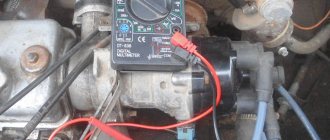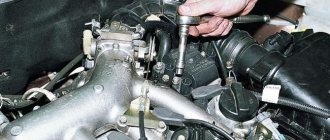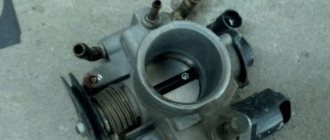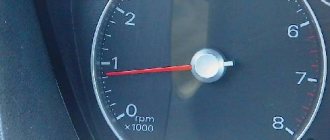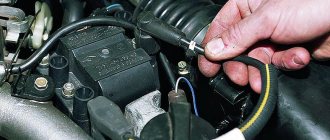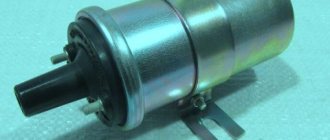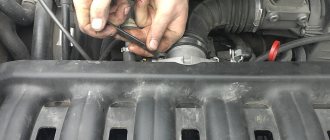In the VAZ 2110 car, injector errors appear quite often. You can see them on the on-board computer, but special tables are needed to decipher them. After all, the ECU produces errors in the form of codes that consist of the letter P and four numbers. Before you begin to solve the problem that has arisen, you should find out what problems there are in the VAZ car.
What to do if the spark in a VAZ 2110 car is lost?
In the VAZ 2110 car, injector errors appear quite often. You can see them on the on-board computer, but special tables are needed to decipher them. After all, the ECU produces errors in the form of codes that consist of the letter P and four numbers. Before you begin to solve the problem that has arisen, you should find out what problems there are in the VAZ car.
VAZ injector errors
Errors can relate to any part of the car:
- Sensors Most often, temperature sensors suffer, as they can overheat too much;
- Injectors. Mostly, problems are observed due to an open circuit, as a result of which they cannot light up in time. This leads to another problem - the spark has disappeared, so the engine does not start;
- Engine. The most common mistake is overheating. Most often, due to increased oiliness, the spark plugs also overheat, so a spark does not appear. As a result, the engine does not emit any signs of life;
- Valves. They can also be too dirty, which will cause them to close, so they will not pass the fuel-air mixture;
- Fans. If they do not work correctly, the machine overheats.
What if the spark is lost?
If the engine does not start, but sounds are made indicating that the fuel pump is working, you should pay attention to the operation of the ignition. First of all, you should check whether the spark has disappeared on the wires with high resistance
To do this, it is necessary to use a spark gap, as well as a Hall sensor, which checks the presence of a magnetic field.
When the spark gap is connected to a VAZ car, you need to crank the engine with the starter. As a rule, a spark appears during this process.
If it is not there, then there is no breakdown to ground of the wire. It is quite possible that the spark was lost due to a break in some wire.
If there is no spark on several wires at the same time, then the controller is most likely faulty.
Hall Sensor
The possibility of breaking high-resistance wires is also not worth it. To do this, you can use a Hall sensor, which helps measure the current in conductors, as well as their resistance
To check the operation of the ignition coils, you should pay attention to whether there are any error codes on the controller. If there is no spark after replacing the coil, then the controller is faulty
Possible errors in VAZ injectors
Codes can indicate malfunctions of any parts and components in the car. Most often this is due to sensors. Temperature sensors are especially affected - they overheat. Car enthusiasts also complain about the injectors. Problems arise due to breaks in the circuit. As a result, they cannot respond on time. This also includes a popular breakdown on the VAZ-2110 - no spark. The 8 valve injector cannot start normally because of this.
Now about engine-related errors. The most common one is overheating. The spark plugs also overheat, causing the spark to disappear. As a result, the motor does not show any signs of life. Next we should consider the valves. These parts may become too dirty, causing them to close completely. They do not allow the necessary mixture of air and fuel to pass through. And finally, the fans - if they do not work, then the power unit will constantly overheat.
VAZ 2112 no spark
If the engine does not start, but you can hear the fuel pump in the tank turning on and running, you need to check the operation of the ignition system. To do this, you need to check for the presence of a spark discharge on high-voltage wires. In this case, be sure to use a spark gap. If you check for a break in the presence of a spark by placing the wire at a certain distance from the ground of the car, the ignition module or controller may fail due to the appearance of a large self-induction current with a large spark gap. In addition, you can get quite noticeable and unpleasant sensations when receiving an electric shock when the insulation breaks down. In the case when you check the spark discharge by placing a spark plug with a non-high-voltage wire on the engine body, also due to poor contact of the spark plug body with ground, a large self-induction current can form, which will lead to damage to the controller or ignition module.
The use of a spark gap is also more convenient, since most injection engines use static ignition distribution with the simultaneous supply of high voltage to two spark plugs. It is not difficult to make a spark gap yourself; here you can find several examples. A drawing of a spark gap for simultaneously checking a spark on four high-voltage wires and a photo for checking a spark on two high-voltage wires. PAfter connecting the spark gap, crank the engine with the starter and observe the presence of a spark discharge. The absence of a spark on one wire, when high voltage is distributed simultaneously to two spark plugs, indicates a breakdown to ground of the wire or the output of the ignition coil (ignition module).
A break in the wire or winding of the ignition coil (module) is also possible. If there is no spark at the same time on a pair of wires 1-4 or 2-3, then the ignition coil, ignition module or controller is faulty. Breakage of high-voltage wires also cannot be ruled out.
To check the integrity of high-voltage wires, it is necessary to check their resistance; it should not exceed 200 kOhm, and there should not be a large difference in resistance in a set of identical wires. To check the ignition coils or module, you need to check for the corresponding error codes in the controller's RAM. If the controller does not have a diagnostic function for the module or coils, then the easiest way is to replace the module with a known good one and repeat the test. If in this case there is no spark on the same wires, then the controller or the wires connecting it to the ignition coil (module) are faulty. When checking the presence of a spark discharge in a static ignition system with an ignition coil on each cylinder, if there is no spark on one of the coils, replace it with any serviceable one from any cylinder.
If a spark appears, the coil is faulty, otherwise the controller or the wire connecting it to the coil is faulty. In the case when there is no spark discharge on any wire, it is necessary to check the presence of power on the ignition coil, and when using a module in the ignition system, also the presence of a minus. For example, on cars with an MP7 controller, you need to check for the presence of a plus on wire 68 by touching it with a test lamp connected to the minus and the presence of a minus on wire 66, with a test lamp connected to the plus. If the supply wires are in good condition, you need to check the serviceability of the sensor.
This can be done in several ways, depending on the controller used and the vehicle. After turning on the ignition and stopping the operation of the fuel pump, if we start cranking the engine with the starter, if the sensor is working, the pump should turn on again. But it must be taken into account that some controllers turn on the fuel pump only when a certain crankshaft speed is reached. You can also connect a test lamp to the terminals of any injector. In this case, during rotation of the crankshaft, if the sensor is working, the warning lamp should flash.
No spark on an injection engine or an engine with a carburetor: how to check
Checking the spark is possible using several methods: to ground, using a multimeter, or a special tester on a piezoelectric element. The first method is the simplest. The body of the unscrewed spark plug is brought to the metal (usually the engine cylinder block), after which the engine is cranked by the starter and the presence of a spark is analyzed.
Please note that this verification method cannot be used when diagnosing fuel-injected vehicles. The fact is that a car with an injector has an ECU and other electrical equipment that is quite sensitive and can be damaged.
The second method allows you to better assess the condition of the spark plug, identify breakdown, etc. The use of a special tester is a method of checking the spark on injector cars, reminiscent in its principle of checking by analyzing the spark breakdown to ground (the first method). In this case, the risk of burning the control unit is minimized. Now let's talk about how to check the spark on a fuel-injected engine.
As mentioned above, a special spark arrester device is used to check the spark on the injector. The presence of this solution during diagnostics allows you to accurately localize the problem area, since the ignition spark may not be on the spark plug, on the distributor or on the coil. Also, there may be no spark in only one, several or all cylinders of the engine.
A complete lack of sparking indicates possible problems with the controller, ignition module, coil or center wire. Diagnostics should begin by checking the fuses. Then you should evaluate the condition of the ground contact, and also check the high-voltage wires.
We also recommend reading the article on how to check high-voltage wires yourself. From this article you will learn about ways to diagnose the condition of ignition spark plug wires with your own hands.
If there is no spark at the ignition coil, then the functionality of the high voltage wire should be checked. The specified wire must be checked for insulation integrity, have no breakdowns, burnt areas, etc. Detection of any defects is grounds for its replacement.
Also, in the process of diagnosing the ignition system, you should inspect the spark plugs. This must be done if electricity reaches the candles. On carburetor cars, it is enough to remove the spark plug wire, and then bring it closer to a metal surface (for example, a car body) by half a centimeter. Then you need to turn the starter and make sure that there is a spark running between the wire and the metal surface. The spark itself should also have a certain intensity, be white with a slight bluish tint. If no deviations are noticed, then the spark plugs are working. The reason that there is no spark at the spark plug may be the ignition coil.
If you notice problems with the spark plugs, then you need to pay attention to the spark plug contacts. These contacts must be free of contamination. Let us add that if deviations from the norm are noticed, it is optimal to immediately replace the spark plugs. Failure to do so will indicate the need to clean the contacts.
Common mistakes during diagnostics
Most people, due to ignorance of the VAZ 2110 injector machine, make many mistakes in the process of identifying problems.
Let's look at some of them:
- Many people make a common mistake: when they see that there is no spark, they want to check it for breaks. For this purpose, they place the wire close to the ground of the machine. But when performing such actions, the ignition module may break, so under no circumstances should you do this;
- Another problem is checking the spark discharge. If you place spark plugs on the engine body, a large induction current may appear. This occurs even due to slight contact of the spark plug with the ground, as a result of which the controller can also be damaged. Therefore, it is necessary to use a spark gap that will not allow the distribution of ignition with the same supply of high voltage to two spark plugs at once.
The engine won't start?
If, as a result of the check, it became clear that the spark hits the spark plugs, but the VAZ 2110 injector engine still does not start, then it is also necessary to diagnose it. The faults that cause this problem can be serious or not very serious.
At the same time, it is sometimes possible to cope with their solution without anyone’s help:
- It is necessary to purchase a spark gap and a Hall Sensor, which is inexpensive, but has an irreplaceable purpose. With their help, you can find out about the presence of a spark in the candles;
- Check the spark plugs to see if they are OK. A spark gap can be used for this purpose. However, you need to remember that the controller will be broken if candles are placed on its body;
- Perform fuel pump diagnostics. When you try to start a VAZ 2110 car, a characteristic sound will appear from under the rear seat. If there is no sound, then you need to check the fuses and the main relay. In a VAZ 2110 car they are located behind the side cover of the driver's seat.
If, after diagnostics, problems were identified with one of these elements, then you can fix them yourself. Usually the spark plugs begin to work after proper wiping, although this does not always happen, so they have to be replaced.
Other faults
If the starter does not rotate, the spark disappears between the ignition switch and this element. This often happens when the battery is discharged or faulty. When tested, a normal battery shows no less than 11.8 V. A faulty ignition cylinder will appear immediately when the driver inserts and turns the key. If turning the key is too easy or too heavy, the lock needs to be replaced. The starter or ignition system relay is also one of the possible reasons for the lack of spark. But you won’t be able to check these nodes yourself. The “retractor” device may be stuck in the starter. In this case, the spark disappears along the way. Experienced car enthusiasts hit the starter with a key or hammer to return the spark. But this is only relevant in field conditions.
What to do if there is no spark in a VAZ-2110 car? Test the starter in the garage using a battery. If you press the body of the device to the “minus” of the battery, and stretch the “plus” wire to the “retractor”, then the device comes to life. Often the spark can disappear where power is supplied to the starter. This circuit is best checked with a multimeter. One cannot do this alone - an assistant will work with the key while the measurements are taken.
Bringing the car back to life
As for why a spark disappears, everything is probably very clear. Now, it would not be amiss to consider the order of her return. The reality is that in most cases, getting the spark back is a simple matter and just involves carefully checking the broken car. To be more precise, to normalize sparking it is required:
- Firstly, check the spark on the injector using the method described above, make sure that it has disappeared, and, at least indirectly, try to determine the cause of the malfunction;
- Next, it is enough to assess the current circumstances and act based on them. As typical situations, we suggest considering solutions to the following problems:
- the spark plug is wet, the presence and strength of the spark are unimportant, the carbon deposits are correct (brick color) - wipe the part and screw it back in;
- the spark plug is wet (not always) and the carbon deposits are incorrect (white or black) - clean, dry the part and try to start the engine, if there is no result, change the spark plug and deal with problems in the fuel system (cleaning the injector, checking the ECU, etc.);
- the spark plug is wet, there is no spark at all, the color of the soot is not important - we try to change the part, if there is no result, we check the ignition system and the operation of the injector.
In principle, in theory there are no particular difficulties in repairs of this kind. Despite this, it often causes difficulties in implementation for inexperienced motorists. To solve these, you need to act in the order described above, but if something doesn’t work out, it’s better to turn to professionals at a service station. This approach to repairs will not only save time, but also guarantee trouble-free operation of the car in the future.
Perhaps this concludes the most important information on today’s issue. We hope that the material presented was useful to you and provided answers to your questions. Good luck in operating and maintaining your car!
Possible breakdowns in the car are divided into 3 main types:
- Fuel system malfunction.
- In electrical.
- Global breakdowns.
Novice car owners with ignition-related malfunctions often say that the spark has disappeared.
How to fix the problem
So, the reason why the spark disappeared has been established. Now you can move on to fixing the problem. If it's all about the ignition coil, then checking with a multimeter will show this. One point should be noted here. If the ignition coil is faulty, then it is best to immediately replace it with a new one. Some people decide to repair this unit on their own, but practice has already proven that this is nothing more than a temporary measure. The result will still be the same - replacing the damaged ignition coil.
The cause may also be a malfunction of the fuel pump. Checking here starts with the simplest. You should turn on the ignition and listen to see if fuel pumping has begun. If the operation of the fuel pump is not heard, you need to check whether fuel is getting into the cylinders. Also inspect the fuse for the fuel pump for integrity. If it fails, replace it. The reason may be directly in the fuel pump itself. In order to find it, you will need to remove the entire module and disassemble it. It is quite easy to check the performance of the pump. To do this, you need to close the contacts through the tester. In the absence of any indicators, the “death of the patient” can be stated. In such a situation, the part must be replaced with a new one. If “the patient is alive,” then you should check the wiring for breaks and clean the contact group.
Another fairly common reason is candles. To make a more accurate diagnosis, we unscrew them one by one and conduct a visual inspection. If nothing like this is found, we proceed to checking the gap and measuring the resistance. You can check the performance of spark plugs on a special stand, but this is unlikely to be in the garage of most motorists.
Therefore, you will have to use the old, time-tested method. We put a high-voltage wire on the previously unscrewed spark plug, and install its base on ground - the car body or engine. Checking for the presence of a spark is carried out when the starter is cranked
It should be noted that it is important to be especially careful with this verification method. It’s best to simply ask one of your neighbors in the garage for a known working kit of a suitable size - this method of checking will be safer
Problems in the operation of the gas distribution mechanism can also cause a lack of spark. However, the timing belt is the last place where you should look for the source of the malfunction. However, sometimes the problem lies in misaligned valve timing due to incorrect installation of the timing disk. It is located on the crankshaft pulley and plays the role of a synchronizer for the sensor. In order to fix the problem, you must install the disk correctly in accordance with the marked marks.
It is quite easy to detect the cause of problems with high-voltage wires. In this case, the engine will stall, and this will manifest itself as noticeable vibration during operation of the power unit. There are two options here - either the wire is faulty, or they are connected incorrectly. In the first case, it is best to change the entire set at once, in the second, rearrange them in the correct sequence.
Note that not all the reasons why the spark on a VAZ-2110 can fail are given here. The problem may arise, for example, with the controller or with a broken wiring. Sometimes it lies on the surface, and in some cases you have to work hard to detect the malfunction. If you are not particularly knowledgeable about the structure of a car, it is best to immediately seek help from a specialist. This option has one main advantage. Diagnostics will not cost that much, but at the same time you will save your time by not wasting it on a lengthy search for the reasons for the lack of a spark.
How to find a spark on a VAZ 2110?
The question “why the spark disappeared on the VAZ 2110” bothered and worries more than one or two drivers of the injection, 8-valve “ten”. Their name is Legion. Of course, some owners will prefer not to bother themselves and will take the car to a service station - let them sort it out.
But there is also a category of drivers who prefer to maintain and repair their car themselves. Actually, the design is not so complicated that you can’t figure it out yourself. Especially if you have experience of similar headaches on carburetor engines.
The search will be thorough, so it is better to stock up on tools - a multimeter, a spark gap and a test light. Why there is no spark and where to look for it is described in detail here: https://etlib.ru/blog/164-net-iskry
Firstly
You should start by checking the fuel pump. If the starter turns, but the engine does not start, this is likely the problem.
First, the fuses are checked, whose mounting block on newer cars has moved from under the glove compartment to the side, behind the console trim on the side of the passenger seat.
If there is nothing wrong with the fuse, then check the activation of the head relay and the fuel pump relay. click should be heard .
If there is no doubt about the operation of the pump, you should verify the presence of fuel in it. This can be checked using a pressure gauge or by pressing the spool at the end of the ramp to see if there is pressure. If the fuel pump is running but there is no pressure, the filter or fuel lines may be clogged.
Possible reasons why there is no charging in the VAZ 2110 injector
Many of these cars have various sensors and components. These additional devices make repairs much more expensive. The electronic injector is equipped with several sensors, malfunctions of which lead to the spark disappearing.
In addition, the following types of breakdowns are possible:
- Malfunctions in the fuel supply system.
- Electronics faults. A fairly common type of breakdown in which there is no spark in the VAZ-2110. The spark plugs do not receive an electrical impulse and the fuel mixture does not ignite.
- Global damage associated with engine failure, bent valves, broken timing belt. Such breakdowns require complex repairs.
The lack of a spark may also be due to a breakdown of the fuel pump relay or this part as a whole. If you insert the key into the ignition switch, turn it and the sound characteristic of the pump does not appear, then the following options are possible: the relay does not function, the wiring is broken, the fuel pump is broken.
You can also check the pump in another way. For this you will need a pressure gauge. It is connected to the fuel supply system and the indicators are measured. If the figure is 2.5 atmospheres, then there is not enough pressure.
Troubleshooting using the ECU is quite simple. Connect the autotester using the OBD connector and find a transcript of the detected errors. Codes P0301, P0302, P0303, P0304 indicate problems in one of the four cylinders, armor wires, spark plugs or gaskets associated with them in accordance with the last digit of the code. If the tester shows error P0300, then you need to check the entire system as a whole, including filters and the composition of the combustible mixture. Problems with the injectors are indicated by codes P0201, P0202, P0203, P0204, etc. (according to the number of cylinders in the power unit). Code P0400 describes a problem in the exhaust manifold.
Domestic models are often equipped with old-generation ECUs. It is better to change such a system at authorized service centers for an updated one that is compatible with the electronics of the car as a whole. Modern units make it easy to detect misfires in specific cylinders.
Causes
There may not be many reasons for the VAZ 2110 engine tripping, but it will be difficult for a beginner to find the fault. Here are some possible causes of a failing cylinder.
- Candles;
- Ignition module;
- Wires;
- Air leak;
- Injector not working;
- ECU;
- valves;
- Piston group;
Let's look at each of the reasons in detail.
Candles
The most likely problem is the spark plugs. Quite often, spark plugs fail, thereby disabling one of the car’s cylinders, or even more. This is due to low-quality fuel at our gas stations. It is recommended to change spark plugs every 30-40 thousand km. You can read how to do this here.
Ignition module
In the VAZ 2110, the ignition module is responsible for the formation of a spark. This is a large coil that produces a spark for every 4 cylinders in pairs of 1-3 and 2-4 cylinders. If the coil is faulty, then two cylinders will not work at once, and not just one.
It is worth noting that the cost of this element is very expensive, around 2000 rubles, to make sure that it is broken, it is best to ask a neighbor for a known good module and install it on your car in order to exclude other causes.
Wires
High-voltage wires conduct the spark from the module to the spark plug. They must have strong insulation and the slightest crack in their insulation leads to a spark breaking through to the body, which will lead to the car shaking. Driving with bad wires can damage the ignition module.
Air leak
It often happens that over time, rubber products and gaskets on VAZ internal combustion engines fail under the influence of high temperatures; they lose their elasticity and begin to leak air. Air leaks, which can affect the combustion of the internal combustion engine, are located on the sealing rings of the injectors and on the corrugations of the receiver or its rings. You can read how to check a car for air leaks in our article.
Injectors
The nozzle is one of the important parts of the car injector; it supplies a portion of fuel into the combustion chamber of the cylinder. Its failure is predicted by one of the non-functioning cylinders. Very often, the injectors become clogged and thus do not ensure normal operation of the internal combustion engine. You can read how to clean the injectors yourself with your own hands here.
The engine control unit contains so-called keys to each cylinder; it is according to their readings that the air-fuel mixture is formed for the operation of the internal combustion engine. When they fail, the correct operation of the engine is out of the question. Fortunately, this happens quite rarely and is very unlikely.
valves
In cars with an 8-valve engine, one of the reasons for tripling is the valves. The bottom line is that in these types of engines the valves are adjusted using special washers. Over time, these washers can wear out, or the camshaft itself wears out, namely its cam and the permissible clearance decreases, as a result of which the valve clamps. For this reason, the fuel mixture enters the cylinder in abnormal parameters.
There is no such problem on 16-valve engines, since hydraulic compensators are installed in such internal combustion engines. They use oil to automatically adjust valve clearance depending on engine temperature.
Some useful recommendations
If one fine morning the owner of a car gets behind the wheel, but cannot start the car, do not despair, let alone panic. You must try to find the cause and make an accurate diagnosis of your sick iron horse. The cause may be a dead battery. It happens that a motorist forgot to turn off the headlights and the car stood there all night with the headlights on. Of course, it is possible to leave, but it is clearly impossible to do without outside help. It is necessary to find out whether the starter rotates. If yes, what is their intensity? It may be that the starter does not turn or click at all. So it just broke down. Then you’ll have to take another car; you’ll hardly have to go anywhere with this one. Of course, the problem may lie in the battery. In the simplest case, the terminal may simply fall off. Then you should tighten their fastening. You can try to leave by starting the car "with a push". But if the car has an automatic transmission, you don’t even have to try to do this. Nothing will come of this. The same applies to electronic fuel injection.
In such a situation, you can try to “light” a neighbor, but on some cars this can damage the on-board computer.
If the starter operates in vigorous mode, but the engine does not start, the battery should not be blamed for this. Most likely the problem lies in the fuel supply or ignition system.
Source
The spark disappeared on the 16-valve VAZ-2112 injector: causes and diagnostics
Many car enthusiasts have encountered the loss of spark on the 16-valve VAZ-2112 engine. What is this defect associated with? The first thing that suggests itself is the ignition. But, in this case, not everything is so simple, since the problem may lie deeper than it seems at first glance.
The video describes a situation when you lose a spark on the road and the car does not start:
What if the spark is lost?
If the engine does not start, but sounds are made indicating that the fuel pump is working, you should pay attention to the operation of the ignition. First of all, you should check whether the spark has disappeared on the wires with high resistance
To do this, it is necessary to use a spark gap, as well as a Hall sensor, which checks the presence of a magnetic field.
The possibility of breaking high-resistance wires is also not worth it. To do this, you can use a Hall sensor, which helps measure the current in conductors, as well as their resistance
To check the operation of the ignition coils, you should pay attention to whether there are any error codes on the controller. If there is no spark after replacing the coil, then the controller is faulty
Hall sensor for system diagnostics
A Hall sensor is a device needed to measure the magnetic field, current, and resistance in conductors. Currently, there are two types of such devices: analog and digital. The latter can determine where there is and where there is no magnetic field. That is, it can be used if the spark in the VAZ 2110 injector is lost.
An analog Hall Sensor converts the field induction into voltage.
And the value shown by him completely depends on the polarity of the field, as well as its strength.
The starter turns, but the car does not move - why?
Here you need to inspect the fuses. Perhaps all the problems come from them. They must be checked for integrity visually or tested with an indicator screwdriver.
In addition, often the inability to start the engine is associated with:
- battery discharge;
- breakdown of the switch that regulates the ignition process;
- terminal oxidation;
- failure of the ignition system coil.
The last breakdown requires replacing the winding with a new one.
And finally, the immobilizer may not allow you to turn on the engine. This element is quite reliable and protects the car well from theft, but sometimes its electronic components malfunction and block the ignition.
conclusions
Loss of spark on a 16-valve VAZ-2112 may be a consequence of the failure of several vehicle components at once or each individually. But, if the operations indicated in the article did not help, then you should contact specialists at a car service center who will accurately identify the cause and eliminate it.
It is unlikely that several nodes will fail at once. This has not happened in my practice. Unless, of course, you hit the car properly.
The ignition coil rarely fails because it is initially reliable. But the spark plugs and fuel pump often fail.
Even if the timing phase is off, there should be a spark!
There will be a spark, but not at the right time when the air-fuel mixture arrives.
the article sucks. wrote the teapot. Moreover, the pump and the spark, and the timing belt. even with a broken timing belt there will be a spark. Kettle...boil somewhere else
What does the fuel pump and broken phases have to do with it? The author is in the furnace.
Wrote 100% who themselves have no idea what they are writing, if on the 12th engine if the spark disappears completely, then 80% is the module, and then 5% each of the crankshaft sensor, ignition switch, ECU and a break in the bus from the brain to the module or crankshaft all
Oh yes, I almost forgot the immobilizer and the signaling may be glitchy
I have a VAZ 2110 2001. First, the fuel pump failed, I found and eliminated the cause; the spark disappeared from the fuel pump; I can’t find the cause yet.
I have the same problem. What helped in the end?
Guys, such garbage, no spark, no prior, crankshaft sensor called, coils too, they put another prior on mine and vice versa, I tried everything and it’s not there??
You write specifically for not all kinds of bullshit.
but there is a spark from the central one, that is, it goes to the distributor, but from the spark plug... oops! Everything was replaced with new ones, BREMI, and it’s still there!
Hello everyone, I have a 2112 16 valve, I turn the starter on the dashboard, all the lower indicators are blinking and the relay is knocking on the right side at the bottom, the car won’t start, I checked the spark and it hits every other time, can the module show off like that?
Exactly the same problem. Didn't find a solution?
Charge the battery, everything will be fine
VAZ 21124 1.6 16kl engine 124 The cylinder head gasket in the 4th cylinder was broken. I dismantled it, cleaned everything, washed it properly, ground the valve, changed the gasket and reassembled it, and now, disappointingly, the engine does not start, there is a spark, there is also fuel. Ignition is normal. The motor sat disassembled for a month. Having rummaged around on your website, I found the reason for the installation, due to inattention, I mixed up the camshafts. Because of my carelessness, I had to re-open the engine and, as it turned out, the truth justified itself. I swapped the camshafts, fortunately the valves on my engine don’t bend. I cleaned the old sealant, degreased it, applied a new one, and assembled everything in the reverse order. And as a result, the engine also does not start, I was upset about my work, it seemed like I was doing everything according to the instructions. This time the reason was the lack of fuel and spark. I racked my brain and checked everything several times but to no avail. I had to resort to this site again, and still found the reason, I started the engine with an uninstalled generator drive pulley. Eliminated the cause, everything was fine, the engine started, everything is normal, thanks for the information
Diagnostics using ODB-2 scanner
Since there are quite a few reasons for the lack of a spark, it is first recommended to carry out a comprehensive diagnosis of the car. A quick way to do this is to use an ODBII scanner.
The main feature of Scan Tool Pro is the diagnosis of not only the engine, but also other components of the car (gearbox, abs, transmission, air conditioning system, etc.). The device works with all models of the domestic automobile industry (since 1993 for gasoline cars and 1996 for diesel cars) and was created specifically for the CIS market - it shows error codes with their interpretation in Russian. The scanner also displays the operation of all available sensors in real time, the vehicle’s VIN, its actual mileage and much more.
Testing for spark
If there is an ignition coil on each of the engine cylinders, then testing for the presence of a spark occurs somewhat differently. In this case you will also need a Hall Sensor. If there is no spark on only one coil, then it should be replaced. But if it doesn't appear at all, then the problem is much more complicated. In this case, the problem may be due to a faulty controller or broken wiring.
To more easily test the presence of a spark discharge, it is advisable to use a Hall Sensor.
It must be brought to the faulty coil and turned on. If the arrow starts to rise, it means there is current in the wires.
Weak spark at spark plugs
The quality of the spark on the spark plugs is checked in the same way as in its absence. However, it is advisable to change the gap with the high-voltage spark plug wire and ground. A spark is considered good if it penetrates a gap of at least 7 mm.
A weak spark on the spark plugs is a malfunction that occurs just as when there is none at all, but it is much more difficult to detect the cause of its occurrence. An ammeter won't even be able to help in this case. The best way to determine a malfunction is to turn off a particular device or section of the circuit from the ignition system and try, if possible, to get a spark without them. The appearance of a good spark indicates a malfunction of the switched off device.
When, after checking, it turns out that the spark between the spark plug and the high-voltage wire is weak, turn off the distributor from the ignition circuit and check the quality of the spark between the ground and the high-voltage wire of the ignition coil. The presence of a strong spark indicates that the entire ignition system to the distributor is working, except for the distributor cap, rotor or high-voltage spark plug wires. If these parts are cracked or broken, they must be replaced.
If, when disconnecting the distributor, the spark remains weak, as before, you should carefully check all the clamps of the low voltage circuit, the cleanliness and reliability of the fastening. If, even after checking the terminals, the spark is weak, it is necessary to turn off the breaker from the low voltage circuit. Its action can be replaced with an additional wire, one end of which is connected to the point of connection of the capacitor wire with the low voltage wire coming from terminal P of the ignition coil, and the other is sharply struck to ground. In this case, the ignition coil wires and the capacitor must be disconnected from terminal K of the breaker.
The occurrence of a strong spark between ground and the high-voltage wire of the coil without the action of the breaker indicates a malfunction of the breaker.
To check the safety and reliability of contact and isolation of current-carrying parts of the circle from ground, you need to check the inner circle of the breaker, the condition and gap in its contacts at all cam protrusions. When checking the inner circle of the breaker, determine whether the cam, the bushings of the breaker shaft, the axis and the hole for the axis of the breaker lever have not worked, and that the breaker panel is securely seated on the bearing.
If the spark is weak and irregular when the breaker is off, then the capacitor or ignition coil is most likely faulty. After making sure that the capacitor is in good condition, you should check the serviceability of the ignition coil. Strong heating of the ignition coil indicates a short circuit in the primary winding. The faulty coil is replaced.
Possible reasons for absence
Most modern cars are equipped with many sensors. They make the life of the car owner easier and complicate repairs. In the electronics responsible for the operation of an injection engine, there are several sensors responsible for the spark formation process. But the reasons that there is no spark (VAZ-2110, injector, 8 valves) may also lie in other components. There are several types of possible breakdowns. The first includes various problems in the car’s fuel system. This includes malfunctions in which fuel cannot enter the cylinders or the supply is interrupted.
If there is no spark (VAZ-2110, injector, 8 valves), then this may be due to the fuel system. Often the pump relay or the submersible element itself fails. The test is performed by ear.
Then there are problems related to the electrical part. These are some of the most common faults. In case of such breakdowns, no electric discharge reaches the spark plug. Naturally, the mixture will not be set on fire. Global problems include complete engine failure and timing belt breakage. It is not worth dwelling on these malfunctions in detail.
The 16-valve VAZ-2110 has no spark
Candles are the first stage of testing. A visual inspection will help find flaws, after which they resort to checking the gaps and measuring the resistance.
Proven method: unscrew the spark plug, put on a high-voltage wire, install the base on the engine or body. After cranking the starter, a spark should form. Safety regulations must be followed.
Another reason may be hidden in the timing belt, namely, if the valve timing has gone astray due to improper installation of the timing disk. It is located on the crankshaft pulley and acts as a synchronizer.
It is quite possible to correct the situation if you change the installation of disks in accordance with the applied marks. The easiest way to find shortcomings is in working with high-voltage wires. However, it is necessary to understand that the engine will operate in strong vibration mode.
What could be the reason:
- The wire doesn't work. A complete replacement helps.
- Incorrect connection. Change the connection location.
There are many reasons that can cause a car to stop working.
The main reasons for the lack of spark
General view of the engine 10-12 series 16 valves
Not all motorists know the reasons for the loss of spark, much less methods for diagnosing and troubleshooting problems. So, it is worth identifying the main reasons, and then deciphering why exactly they become the cause. Finally, you need to consider ways to eliminate the defect. So, what reasons could cause the spark to disappear:
All the reasons have been found and it is worth moving on to the process of eliminating this malfunction.
Are you giving me a spark? Troubleshooting!
First of all, it’s worth noting that you don’t need to rush to check right away. As practice shows, there is a certain sequence of actions and malfunctions that could lead to loss of spark on a 16-valve engine.
Fuel pump
Fuel pump made by Bosch
Ignition is not the first reason for the ignition failure on a car. Before getting into the electrical part of the car, it’s worth delving into the mechanics, so to speak. Turn on the ignition and listen to see if the gasoline pump is working. If it is silent, then you need to check whether gasoline is entering the cylinders.
It is worth starting the diagnostic procedure by checking the fuses for serviceability. Of course, you can only view the one that is responsible for the fuel pump (in this case, when you turn on the ignition, the pump will not pump), but it is recommended to diagnose everything for integrity. If at least one fails, it must be replaced.
The fuses are located to the left of the steering wheel under the light mode switch
If the previous procedure did not help, then we turn directly to the pump itself. For diagnostics, you will have to remove the entire module, which is located under the rear sofa, and disassemble it.
Spark plug
Location of spark plugs on the engine
The candle becomes the second boundary, which may cause the spark to disappear. We unscrew the elements and carry out visual diagnostics. If everything is clean and beautiful outside, then you need to measure the resistance and check the gap. Of course, you can check the performance of a spark plug on a special spark plug stand, but not everyone has one in their garage. Therefore, we do everything the old fashioned way.
When performing this operation, you should be extremely careful, since the voltage that enters the spark can be fatal. Thus, we check all the spark plugs for the presence of a spark.
An alternative way to check spark plugs
Checking the spark plug using a piezo element from a conventional lighter
Ignition coil
Repaired ignition coil
The ignition coil can be checked using a multimeter. If it is faulty, it is recommended to replace it, but there are brave souls who repair this unit. Of course, not everything always goes smoothly and often everything ends in one thing - the installation of a new one.
High voltage wires
Checking the high-voltage wire with a multimeter
A breakdown or failure of the wire will immediately become known as the car will start to shake. But, if the explosive wires are located incorrectly in the cylinders, then you will have to place them according to the connection diagram. The missing spark problem should go away.
The last place to look for a missing spark is the timing belt. Misaligned valve timing can be a problem. This could happen due to incorrect installation of the deposit disk. It is located on the crankshaft pulley and serves as a reference synchronizer for the sensor. If it is positioned correctly, when 1 cylinder is in the TTM, the sensor is placed between the 19th and 20th teeth. You can eliminate the cause by setting the disk correctly to the marks.
Checking the ignition coil for spark
To diagnose the performance of the coil, remove the wire from the distributor-breaker. Next, the test is carried out similarly to testing high-voltage wires, that is, the wire is brought to a metal surface and turned with a starter. The presence of a spark will indicate in this case a problem with the ignition distributor; if there is no spark, then the problem lies in the coil.
First you need to check the distributor contacts. These contacts may oxidize, insulation damage is also possible, and the rotor itself may be faulty. Detecting problems with the rotor allows you to eliminate the problem by replacing it. When checking the ignition coil, you should identify possible defects in the integrity of the winding, burnouts and other signs that a short circuit is occurring inside. If such signs are found, the coil should be replaced or the ignition coil should be repaired.
Let us add that the presence of a spark on the spark plugs does not mean that the car must start. This is especially true for injection engines, where the failure of certain sensors or ECUs can make it very difficult or completely impossible to start the power unit. In such cases, there is a spark, fuel is supplied, but the engine still does not start. The ignition switch also deserves special attention, since malfunctions can occur in this place.
Now let's take a closer look at ways to check the main elements of the ignition system. To do this, let's go back to the coil. As already mentioned, the most common cause of a malfunction is a damaged winding. Then an insulation breakdown occurs and a short circuit occurs. It is also important to understand that the coil can fail due to overload. Such increased loads occur as a result of problematic spark plugs or spark plug wires. For diagnosis you should:
After evaluating the spark, you can decide whether the ignition coil needs to be replaced. Please note that repairing this element is often impractical. Also, when installing a new spare part, you should strictly adhere to the required polarity. If this is not done, then the new part will quickly become unusable after unqualified installation. Please note that car service centers use a special stand to check coils. Such equipment allows you to check the coil taking into account various operating modes.
Stage two
If there is no spark on a VAZ-2110 (injector, 8 valves), then the spark plugs are often the cause. Naturally, they are checked if the fuel pump is working. It is best to use a spark gap for testing. If the current is distributed over two spark plugs, then there will definitely be a breakdown to ground.
It is possible that the wire to the ignition coil has broken or there are breaks in its winding. If a VAZ-2110 car does not have a spark (injector, 8 valves) on two wires, then the reasons may be a non-working ignition coil or controller. In two cases, there is a possibility of high-voltage wires breaking. This option is worth checking first. Look at the resistance level. Normal values are up to 200 kOhm.
Ignition module and coil
Here you can check the error codes that are in the car's memory. If the ECU does not have a diagnostic function, you should install a known-good module.
You can find out why there is no spark on the VAZ-2110 (injector, 8 valves) by looking at the faulty controller. It is also possible that the wires from the controller to the ignition coil may break. If there is no spark on each of the coils, you should make sure there is power. If there is no electrical discharge for some reason, then the element must be replaced. The system has an ignition module. Therefore, a useful operation would be to check the “minus”.
Ignition problems
In practical use of a car, this problem occurs quite often and explains the reason why the VAZ 2110 16-valve injector does not start. The cause of this problem is increased vibration. The distributor is protected by a special cover. Over time, it may simply unwind. This will cause a circumstance to arise in which the spark will not be supplied correctly. The fuel will not burn completely and an effect will occur, which among motorists is called “triple”. Of course, in such cases it is necessary to adjust the ignition. There may be a situation in which the spark plugs get wet when the starter is working. Then you need to try to replace them.
If this does not give the expected result, then follow these steps:
- Check the condition of the injectors. Sometimes the cause of the malfunction is that they are simply clogged. The problem can be resolved by simply washing them.
- An inspection of the gasoline pump is required. It is necessary to make sure that its operation leads to the creation of the necessary pressure.
- When looking for possible causes, you should inspect the MAF sensor. It may not operate properly, causing too much fuel to be supplied. In this case, a situation may also arise in which the VAZ 2110 seizes, but does not start. The throttle valve or DHW may be clogged. They should be washed with the liquid used to clean the carburetor.
In frosty weather, it may be that the starter turns, but the VAZ 2110 does not start. In this case, you must perform the following actions:
- With the spark plugs removed, you need to crank the starter. This is required for fuel to leave the engine;
- replace the spark plugs. They need to be warmed up first;
- engine starting required;
- carry out steps to charge the battery.
If all the actions taken did not give a positive result, then this may indicate a more serious breakdown. Then turning to specialists cannot be avoided.
It happens that the owner of the car has changed the ignition switch. The engine started, but stopped doing so after the steering unit was completely assembled. In this case, it is necessary to check the fuel pump.
Doesn't start well and boils
In this case, the reason lies in the coolant. Check its level. If necessary, dilute with distilled water. However, there is no need to mix different brands of antifreeze. It may foam, which will further accelerate overheating.
The thermostat may also break. The VAZ 2110 8-valve injector is equipped with a two-piston element. It's very easy to check. To do this, you need a burner and a pan of water. Place the thermostat in the container and wait for the water to boil. If bubbles appear and the piston does not move, it means the element is faulty. The temperature at which it should operate is indicated on the metal body of the thermostat. The element cannot be repaired - it must only be replaced. As a result, the system is unable to regulate the operating temperature of the antifreeze. The coolant moves only in a small circle. But the car may start poorly (every once in a while) due to an incorrectly adjusted ignition. Most "ten" cars have a distributor ignition. Here you need to set the correct lead angle.
There is no spark, but the starter turns
In the VAZ 2110, the ignition module is considered a problem area. You can check it if you find a working device from friends and install it on your car.
If the problem is with the module, then after the steps described earlier, the engine should start without problems. Power may not be supplied to the chip connected to the module. If this is present, it is worth checking the entire power supply system.
DPCV may be the cause of the loss of spark. This sensor is considered the main one in the entire ignition system and helps monitor the operation of the cylinders. You can check the operating status of this unit with an oscilloscope. It is impossible to independently determine whether this module is in working condition. Perhaps the best solution is to replace the sensor.
The ECU may also be to blame for failures, which leads to the fact that there is no spark in the injector of 8 valves of the VAZ-2110. If this module does not work correctly, then the spark may not flow to all cylinders. Repairing this device is simple. There may be no spark due to oxide on the contacts. It should be removed.
Nothing happens when I turn the key in the lock.
Other causes of problems with engine starting may be breakdowns:
The spark in the VAZ-2110 often disappears for another reason - banal oxidation of the contacts. We have already mentioned cleaning them from oxidation; if servicing the ECU did not help, then you should look at other wires. For example, trace the course of a mass conductor. The most vulnerable places on it are where it contacts the body and approaches the battery terminal. If a fault is found at the terminal, replace the wire. At the point of contact with the body, it is enough to simply clean it with a metal brush.
Source
